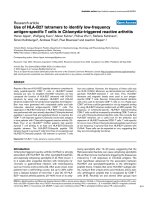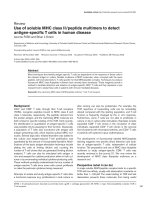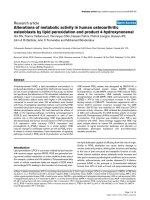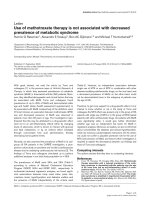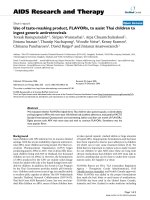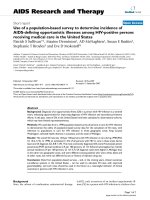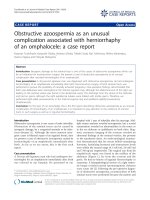Báo cáo y học: "Use of methotrexate therapy is not associated with decreased prevalence of metabolic syndrome" potx
Bạn đang xem bản rút gọn của tài liệu. Xem và tải ngay bản đầy đủ của tài liệu tại đây (44.17 KB, 2 trang )
Available online />Page 1 of 2
(page number not for citation purposes)
With great interest, we read the article by Toms and
colleagues [1] in the previous issue of Arthritis Research &
Therapy, in which they assessed prevalences of metabolic
syndrome (MetS) in rheumatoid arthritis (RA) patients. More-
over, they identified demographic and clinical factors that may
be associated with MetS. Toms and colleagues found
prevalences of up to 45% of MetS and demonstrated older
age and health status (health assessment questionnaire) to
be associated with MetS irrespectively of the definition used.
Of most interest, an association between methotrexate (MTX)
use and decreased presence of MetS was observed in
patients more than 60 years of age. The investigators hypo-
thesized that this may be attributed to a drug-specific effect
(and not to an anti-inflammatory effect) either by changing
levels of adenosine, which is known to interact with glucose
and lipid metabolism, or by an indirect effect mediated
through concomitant folic acid administration, thereby
decreasing homocysteine levels.
Recently, we also examined the prevalence of MetS in (a sub-
group of) RA patients in the CARRÉ investigation, a pros-
pective cohort study on prevalent and incident cardiovascular
disease and its underlying cardiovascular risk factors [2]. The
findings of Toms and colleagues stimulated us to perform
additional analyses in our total study population (n = 353).
The prevalences of MetS were 35% and 25% (Table 1)
according to criteria of National Cholesterol Education
Program (NCEP) 2004 and NCEP 2001, respectively. In
multivariate backward regression analyses, we found signifi-
cant associations between body mass index, pulse rate,
creatinine levels, hypothyroidism and diabetes mellitus and
the presence of MetS independently of the criteria used
(Table 2). However, an independent association between
single use of MTX or use of MTX in combination with other
disease-modifying antirheumatic drugs, on the one hand, and
a decreased prevalence of MetS, on the other hand, could
not be demonstrated (even in the subgroup of patients over
the age of 60).
Therefore, to get more support for a drug-specific effect, it is of
interest to know whether or not in the study of Toms and
colleagues the MTX effect was present only in the group of RA
patients with single use of MTX or in the group of MTX-treated
patients with other antirheumatic drugs. As patients with MetS
were significantly older, it would give further information
whether age was an independent risk factor for MetS in
regression analyses. Moreover, as readers, we are not informed
about comorbidities like diabetes and clinical hypothyroidism,
which are notorious cardiometabolic risk factors. On the whole,
we could not confirm a plausible protective role for the use of
MTX and presence of MetS, and hence further investigation is
required to explain the discrepancy between our findings and
those of Toms and colleagues.
Competing interests
The authors declare that they have no competing interests.
References
1. Toms TE, Panoulas VF, Douglas KMJ, Kitas GD: Methotrexate
therapy associates with a reduced prevalence of the meta-
bolic syndrome in rheumatoid arthritis patients over the age
of 60: more than just an anti-inflammatory effect? A cross-
sectional study. Arthritis Res Ther 2009, 11:R110.
2. Raterman HG, van Eijk IC, Voskuyl AE, Peters MJ, Dijkmans BA,
van Halm VP, Simsek S, Lems WF, Nurmohamed MT: The meta-
bolic syndrome is amplified in hypothyroid rheumatoid arthri-
tis patients: a cross-sectional study. Ann Rheum Dis 2008 Dec
22. [Epub ahead of print].
Letter
Use of methotrexate therapy is not associated with decreased
prevalence of metabolic syndrome
Hennie G Raterman
1
, Alexandre E Voskuyl
1
, Ben AC Dijkmans
1,2
and Michael T Nurmohamed
2,3
1
Department of Rheumatology, VU University Medical Center, De Boelelaan 1117, 1081 HV, Amsterdam, The Netherlands
2
Department of Rheumatology, Jan van Breemen Institue, Dr Jan van Breemenstraat 2, 1056 AB Amsterdam, The Netherlands
3
Department of Internal Medicine, VU University Medical Center, De Boelelaan 1117, 1081 HV, Amsterdam, The Netherlands
Corresponding author: Michael T Nurmohamed,
Published: 21 September 2009 Arthritis Research & Therapy 2009, 11:413 (doi:10.1186/ar2805)
This article is online at />© 2009 BioMed Central Ltd
See related research by Toms et al., and related letter by Toms et al.,
/>MetS = metabolic syndrome; MTX = methotrexate; NCEP = National Cholesterol Education Program; RA = rheumatoid arthritis.
Arthritis Research & Therapy Vol 11 No 5 Raterman et al.
Page 2 of 2
(page number not for citation purposes)
Table 1
Characteristics of the study population
MetS present
a
MetS absent
a
MetS present
b
MetS absent
b
n = 84 n = 265 n = 121 n = 228 P value
a
P value
b
Demographics
Age, years 63.8 (± 8) 63.1 (± 7) 64.3 (± 8) 62.7 (± 7) 0.46 0.045
Female, percentage 76 63 74 62 0.022 0.028
RA-related characteristics
DAS28 4.2 (± 1.3) 3.9 (± 1.4) 4.1 (± 1.3) 3.8 (± 1.4) 0.21 0.062
ESR, mm/hour 22 (10-35) 16 (9-30) 20 (10-34) 17 (9-31) 0.059 0.33
CRP, mg/L 11 (4-21) 6 (3-16) 8 (3-18) 6 (3-19) 0.021 0.46
RA duration, years 7 (4-10) 7 (4-10) 7 (4-10) 7 (5-10) 0.83 0.19
Erosion, percentage 77 83 79 83 0.20 0.36
Number of DMARDs 1 (1-2) 1 (1-1) 1 (1-2) 1 (1-1) 0.26 0.43
MTX current, percentage 62 60 63 59 0.71 0.46
MTX only, percentage 39 39 41 38 0.95 0.67
SSZ only, percentage 8 13 9 14 0.23 0.22
HCQ only, percentage 1 4 3 4 0.31 0.55
Combination of DMARDs, percentage 31 25 29 25 0.24 0.38
TNF-blocking agent, percentage 11 9 11 9 0.73 0.65
Prednisolone only, percentage 1 2 3 1 1.00 0.42
Cardiovascular risk factors
Current smoker, percentage 26 31 25 32 0.42 0.15
Pack-years, years 17 (0-34) 19 (2-38) 19 (0-35) 18 (2-38) 0.23 0.75
BMI, kg/m
2
30 (± 4) 26 (± 5) 29 (± 4) 25 (± 5) <0.001 <0.001
Creatinine, μmol/L 89 (± 21) 89 (± 16) 91 (± 22) 87 (± 14) 0.99 0.070
Renal clearance, mL/minute 81 (± 24) 72 (± 19) 77 (± 23) 73 (± 19) 0.003 0.062
Pulse, beats per minute 76 (± 11) 73 (± 9) 75 (± 11) 73 (± 9) 0.005 0.015
Diabetes mellitus, percentage 14 3 12 3 <0.001 0.001
Hypothyroidism, percentage 12 2 9 2 0.001 0.003
a
Metabolic syndrome (MetS) according to National Cholesterol Education Program (NCEP) 2001;
b
MetS according to NCEP 2004. Continuous
variables are presented as means (± standard deviations) in cases of normal distribution or as medians (interquartile ranges) in cases of non-
normal distribution. BMI, body mass index; CRP, C-reactive protein; DAS28, disease activity score using 28 joint counts; DMARD, disease-
modifying antirheumatic drug; ESR, erythrocyte sedimentation rate; HCQ, hydroxychloroquine; MTX, methotrexate; RA, rheumatoid arthritis; SSZ,
sulfasalazine; TNF, tumour necrosis factor.
Table 2
Variables associated with metabolic syndrome
Univariate Multivariate
a
OR 95% CI P value OR 95% CI P value
Body mass index 1.2 1.1-1.3 <0.001 1.2 1.1-1.3 <0.001
Pulse 1.03 1.01-1.06 0.011 1.03 1.00-1.06 0.020
Creatinine 1.01 1.00-1.02 0.080 1.02 1.00-1.03 0.017
Hypothyroidism 4.5 1.5-13.2 0.007 4.7 1.5-15.0 0.009
Diabetes mellitus 4.8 1.8-12.9 0.002 4.5 1.4-15.2 0.014
a
In multivariate analyses, the following variables were used: gender, age, prednisolone only, methotrexate only, sulfasalazine only,
hydroxychloroquine only, tumour necrosis factor-blocking agents, combination of disease-modifying antirheumatic drugs, pack-years, smoking,
erosions, DAS28 (disease activity score using 28 joint counts), body mass index, pulse rate, creatinine levels, renal clearance, hypothyroidism and
diabetes mellitus. CI, confidence interval; OR, odds ratio.

